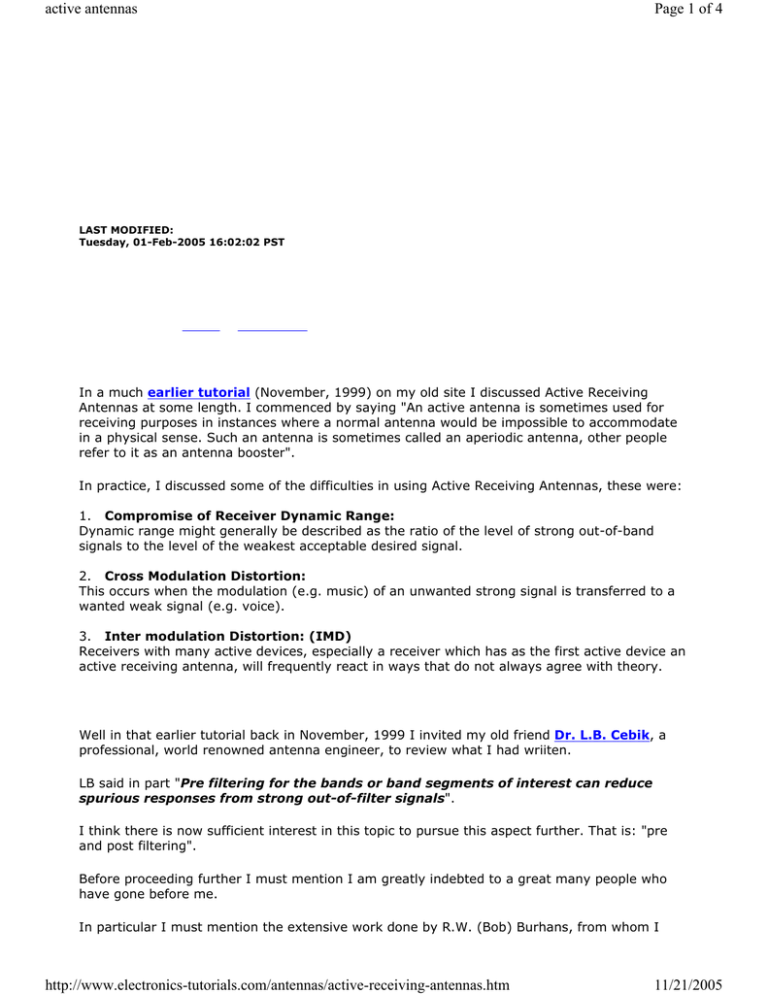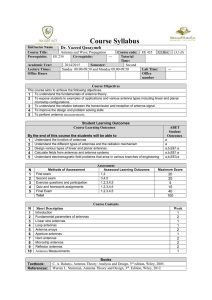www.electronics-tutorials.com
advertisement

active antennas Page 1 of 4 www.electronics-tutorials.com LAST MODIFIED: Tuesday, 01-Feb-2005 16:02:02 PST ACTIVE RECEIVING ANTENNAS YOU ARE HERE: HOME > ANTENNAS > ACTIVE RECEIVING ANTENNAS What are active receiving antennas? In a much earlier tutorial (November, 1999) on my old site I discussed Active Receiving Antennas at some length. I commenced by saying "An active antenna is sometimes used for receiving purposes in instances where a normal antenna would be impossible to accommodate in a physical sense. Such an antenna is sometimes called an aperiodic antenna, other people refer to it as an antenna booster". In practice, I discussed some of the difficulties in using Active Receiving Antennas, these were: 1. Compromise of Receiver Dynamic Range: Dynamic range might generally be described as the ratio of the level of strong out-of-band signals to the level of the weakest acceptable desired signal. 2. Cross Modulation Distortion: This occurs when the modulation (e.g. music) of an unwanted strong signal is transferred to a wanted weak signal (e.g. voice). 3. Inter modulation Distortion: (IMD) Receivers with many active devices, especially a receiver which has as the first active device an active receiving antenna, will frequently react in ways that do not always agree with theory. How can we improve active receiving antennas? Well in that earlier tutorial back in November, 1999 I invited my old friend Dr. L.B. Cebik, a professional, world renowned antenna engineer, to review what I had wriiten. LB said in part "Pre filtering for the bands or band segments of interest can reduce spurious responses from strong out-of-filter signals". I think there is now sufficient interest in this topic to pursue this aspect further. That is: "pre and post filtering". Before proceeding further I must mention I am greatly indebted to a great many people who have gone before me. In particular I must mention the extensive work done by R.W. (Bob) Burhans, from whom I http://www.electronics-tutorials.com/antennas/active-receiving-antennas.htm 11/21/2005 active antennas Page 2 of 4 learnt a great deal in this area. To my ever-lasting regret I have neither met nor corresponded with Bob, I am totally unable to contact him. Bob, at one time lived in Athens, Ohio, U.SA. I fear the worst... Serious students of this topic should in particular seek out Bob's series of articles on active receiving antennas which appeared in the now defunct Radio-Electronics Magazine throughout the first half of 1983. Let's take a look at a rough schematic of a typical active receiving antenna without any embellishment: Figure 1 - typical active receiving antenna What we have here is a small antenna, typically one metre long and perhaps representing a capacitor of around 20 pF, feeding the high impedance input of a source follower amplifier. The amplifier also has an input capacitance, say 7 pF for J310 type J-Fets. The source follower has a low output impedance suitable for connecting to a coaxial cable. Why do we do all this weird stuff? Let's consider why we use only a nominal one metre long antenna. I'm told Bob once wrote an article using a 50 mm (2") antenna, I never saw it (that's a hint to any reader who has) but I can well imagine the justification. The reason is quite simple, at ANY point in space Signal "X" will have a certain field strength, similarly noise (the enemy) will also have a certain field strength. Increasing the antenna length will certainly increase the available signal to our input. Unfortunately the available noise increases by the same magnitude, the ratio between the two at your point in space is fixed. What we are after is an amplifier which has a sufficiently low noise figure that it will amplify the signal without introducing significant additional noise. It will have a sufficiently high input impedance that it does not represent a dead short to the antenna (as the 50 ohm input of a receiver probably would). The output impedance should be similarly low as to comfortably drive a coaxial cable with a receiver attached. Basicly we're looking at an "impedance converter". What in reality we are looking at is a buffer amplifier. I strongly suggest you print out both tutorials, impedance and buffer amplifiers, it will probably make life somewhat easier from here onwards. It is quite critical to your understanding of this topic that you realise a physically short antenna (in terms of wavelength) sees the receiver input terminals as virtually a dead short, especially http://www.electronics-tutorials.com/antennas/active-receiving-antennas.htm 11/21/2005 active antennas Page 3 of 4 at lower frequencies where such an antenna may represent only a tiny fraction of a wavelength. How can we modify the input circuits of our active receiving antenna? By absorption of the antenna capacitance and the fet input capacitance into certain networks we can achieve a great number of goals. We can absorb these reactances into a low pass filter for example. For the most part, I will be referring to the fixed frequency 5 Mhz (or 5000 Khz) as may be used in my pet project "Radio VNG 5 Mhz Receiver". All you need do is follow the principles to convert to any band of interest. Now for a single frequency or, even a particular band or sub-band what can I do? (a) I could employ a narrow band filter centred at 5 Mhz. (b) I could employ a low pass filter just above 5 Mhz. (c) I could employ a high pass filter just below 5 Mhz. In figure 2 below we will examine the prospect of a narrow band filter centred at 5 Mhz. Figure 2 - active receiving antenna narrow band filter If you followed the tutorial on narrow band filters it should be fairly easy. Low input impedance approach Dick Rollema, PAØSE has "Another Approach to Active Antennas" page where he says in part: "As a result the E-field probe, a piece of copper tube of 50cm long and 3cm diameter, now feeds a current into the FET at the input. Because of the probe's capacitive impedance the current increases with frequency at 6dB/octave. This is compensated by negative feedback. Nordholt calls it an 'integrating transimpedance amplifier in order to obtain a frequency independent transfer of the antenna signal'." Read Dick's story here. My friend Chris Trask has a list of interesting Active Antenna References for the purists these are not links. Ads by Google Active Filter High Gain Antenna HF Antennas http://www.electronics-tutorials.com/antennas/active-receiving-antennas.htm Antenna Amplifiers Ham Radio A 11/21/2005 active antennas Page 4 of 4 Got a question on this topic? If you are involved in electronics then consider joining our "electronics Questions and Answers" news group to ask your question there as well as sharing your thorny questions and answers. Help out your colleagues!. The absolute fastest way to get your question answered and yes, I DO read most posts. This is a mutual help group with a very professional air about it. I've learn't things. Not for absolute newcomers to ask questions BUT it is an excellent learning resource for lurkers. RELATED TOPICS ON ACTIVE RECEIVING ANTENNAS antenna basics narrow band filters earth dangers impedance mobius winding techniques radio telescopes I would also suggest that you take a good look at L.B. Cebik 's W4RNL great web site. My good friend LB is "THE antenna guru" YOU ARE HERE: HOME > ANTENNAS > ACTIVE RECEIVING ANTENNAS the author Ian C. Purdie, VK2TIP of www.electronics-tutorials.com asserts the moral right to be identified as the author of this web site and all contents herein. Copyright © 2000, all rights reserved. See copying and links. These electronic tutorials are provided for individual private use and the author assumes no liability whatsoever for the application, use, misuse, of any of these projects or electronics tutorials that may result in the direct or indirect damage or loss that comes from these projects or tutorials. All materials are provided for free private and public use. Commercial use prohibited without prior written permission from www.electronics-tutorials.com. Copyright © 2000 - 2001, all rights reserved. URL - http://www.electronics-tutorials.com/antennas/active-receivingantennas.htm Updated 21st April, 2002 webmaster@electronics-tutorials.com http://www.electronics-tutorials.com/antennas/active-receiving-antennas.htm 11/21/2005

![EEE 443 Antennas for Wireless Communications (3) [S]](http://s3.studylib.net/store/data/008888255_1-6e942a081653d05c33fa53deefb4441a-300x300.png)

